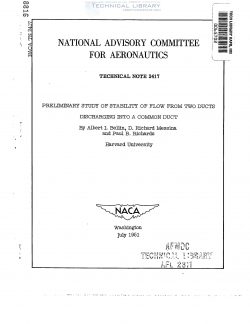naca-tn-2417
- Version
- 50 Downloads
- 1.12 MB File Size
- 1 File Count
- December 14, 2016 Create Date
- December 14, 2016 Last Updated
National Advisory Committee for Aeronautics, Technical Notes - Preliminary Study of Stability of Flow from Two Ducts Discharging into a Common Duct

This research is a preliminary investigation of the instability of
flow from two ducts that Join into a common duct and of the influence
of the various parameters upon the phenomenon.
A two-dimensional potential analysis was carried out under the
assumption that the two ducts discharge into a region of constant pres—
sure. For this problem, there exists a unique solution if a Jbukowski
hypothesis is imposed; also, the results indicate the flow to be stable
with respect to small changes in the physical parameters. This is con—
firmed by experiments with a two-dimensional water table. The simr
plified model, therefore, does not explain oscillations and asymmetries
of flow for actual symmetric duct configurations.
The problem is reconsidered with the assumption of turbulent mixing
between the Jet from the two ducts and the surrounding fluid in the
common duct. On this basis, qualitative considerations indicate that
self—excited forces may arise to account for observed instabilities.
Experiments with a two—dimensional water table indicate three dif-
ferent flow regimes for a symmetric system of two ducts that converge
and discharge into an expanded duct (or sink):
(1) For a ratio of sink width to duct width of about 55, the jet
leaving the two ducts oscillates about the symmetry axis. Under
certain conditions, the oscillations are periodic.
(2) For a ratio of sink width to duct width of about 35, there are
three flows possible. Two are steady with the Jet asymmetric; the third
is periodic with the Jet moving laterally about the symmetry axis.
(3) For a ratio of sink width to duct width of about 20, the flow
is steady with the Jet asymmetric to the right or left.
In the last two cases, sufficiently large external disturbances shift
the flow from one pattern to another. The periodic oscillations of the
jet have a frequency of the order of 0.30 cycle per second and an
amplitude of 5° to 10°.
| File | Action |
|---|---|
| naca-tn-2417 Preliminary Study of Stability of Flow from Two Ducts Discharging into a Common Duct.pdf | Download |
Comment On This Post